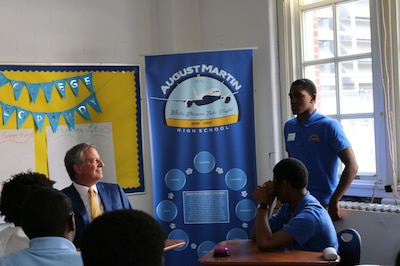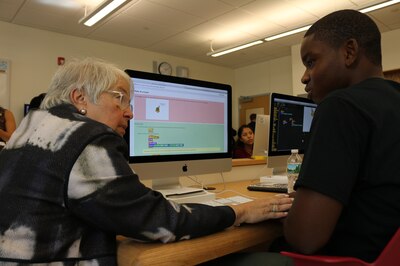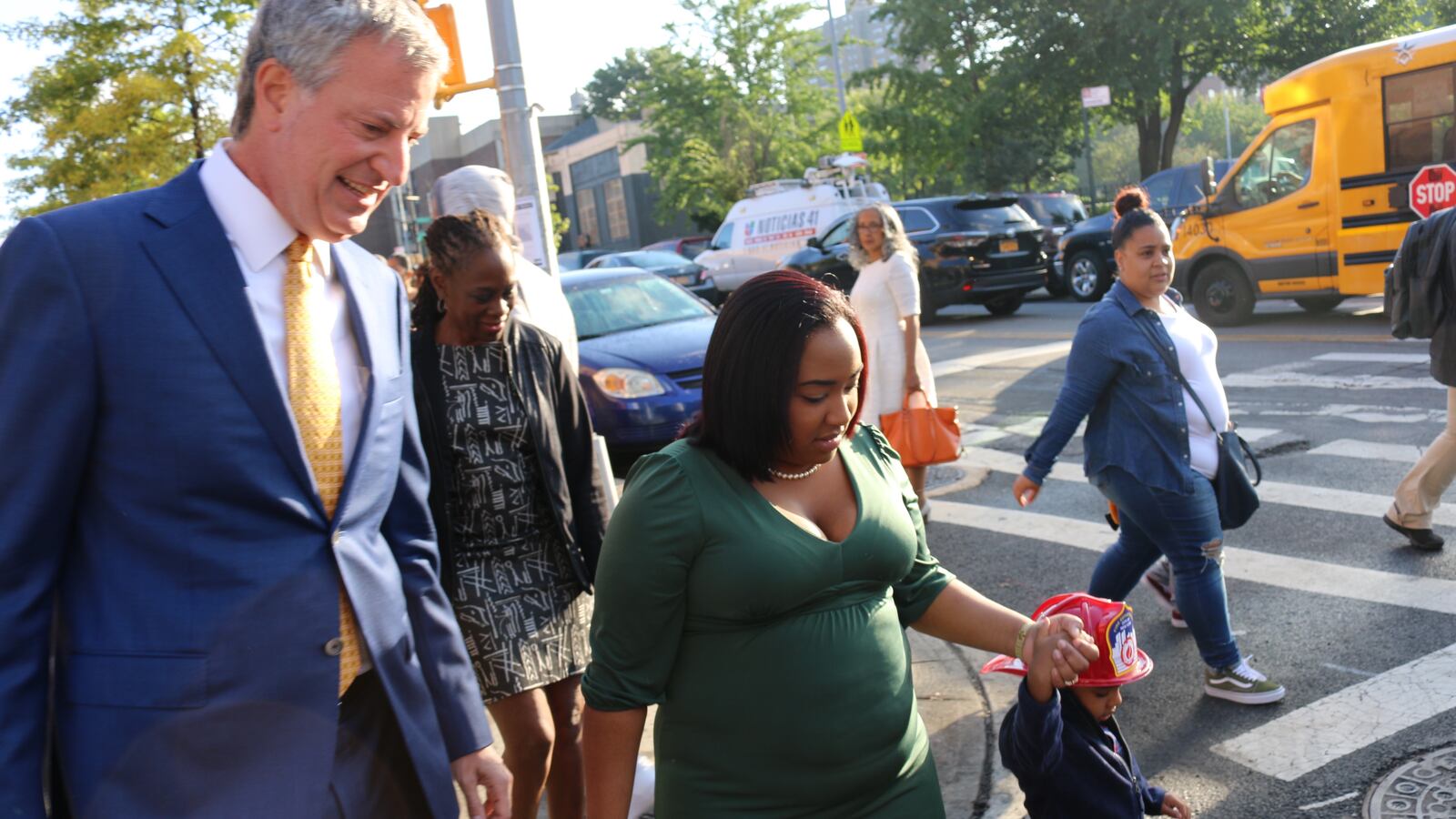As school began Thursday for over a million students in New York City, Mayor Bill de Blasio and schools Chancellor Carmen Fariña criss-crossed the city, with plans to visit classrooms in every borough.
The yearly tradition marks an opportunity for the mayor, who is facing re-election this fall, to make the case that his education agenda is paying off and to tout several newly unveiled initiatives: free preschool for three-year-olds, more computer-science classes, and an expanded free-lunch program that now includes all students.
Throughout the day, we’ll post dispatches from the mayor and chancellor’s citywide school tour.
Kicking off the school year with the city’s youngest students
7:57 a.m.: De Blasio began the day walking to school with 3-year-old Joel Lopez, a member of the school system’s youngest and newest cohort. Under the city’s new 3-K for All program, two districts in the Brooklyn and Bronx will begin serving nearly 800 3-year-olds this school fall — a downward expansion of free pre-kindergarten for all 4-year-olds, the mayor’s signature education accomplishment. (The education department will also provide support for an additional 577 3-year-olds enrolled in early-learning centers in those districts.)
Along with Fariña, the mayor and Joel strolled into a basement classroom at the Bronx’s P.S. 277, where students got to work right away. They sat at small rectangular tables pulling apart pieces of pink and blue Play-Doh, as their teachers hovered above them.
Astrea Ramirez, Joel’s mother, said she heard about the 3-K program through a family member and signed up immediately. “I would have had to pay out-of-pocket for daycare,” she said, adding that she hopes the new program will jump-start her son’s education. “At this age, they’re sponges.”
With fewer than 1,400 students, the new 3-K program is far smaller than the mayor’s ambitious program for 4-year-olds, which is open to every child and currently serves over 70,000 students. Still, de Blasio said the new program is part of his administration’s push to ensure students have access to high-quality education during their crucial early-developmental years.
“A whole generation of our children are going to get that great education from the beginning,” de Blasio said. “What we’re seeing here today is the beginning of something very big.”
College talk at a struggling high school
11:13 a.m.: Later this morning, the mayor headed to Queens to talk college with teenagers and check in on a high school in his closely watched “Renewal” program for struggling schools.

Stepping into a blue-tiled classroom in the South Jamaica neighborhood, he observed students in polo shirts and khakis playing a game of “College-and-Career Jeopardy.” The students, who attend separate schools in the same building, eagerly answered questions like: “What are the three things you need to fill out your FAFSA?” and whether students with middling academic records should apply to colleges that look for higher-than-average SAT scores and grades. (The answer: Yes!)
The visit was meant to highlight a collaboration between a low-performing district school, August Martin High School, and a charter school on the same campus, New Visions Charter High School for Advanced Math and Science IV. About 120 partnerships exist across the city, officials said.
This year, August Martin seniors are helping mentor New Visions’ juniors on how to navigate the college application process. One August Martin student, Stephon Jones, said his biggest piece of advice is to start thinking early on about what you want out of college. “That’s going to help me find the career I want,” he said, adding that he’s considering becoming an actor or wrestler.
Mayor de Blasio dispensed some college advice of his own, encouraging students not to be intimidated by the college application process. While the visit focused on college planning, it did not call attention to the fact that August Martin has been among the lowest-performing schools in the city — and one the mayor is trying to turn around through his $582 million Renewal program.
In 2016, the school’s four-year graduation rate was 39 percent — a far cry from the citywide rate of 73 percent that year and lower than the 59 percent rate among Renewal high schools. Graduation rates from 2017 have not yet been released, but Principal Rory Parnell said August Martin’s improved significantly this year, climbing to about 64 percent.
Parnell said she has been working hard to turn the school around after it was labeled “out of time” by the state and has suffered a declining enrollment. She’s boosted its music program (plastic storage containers no longer double as drums), instituted a uniform policy, and has pushed her teachers — just two of whom have been at the school longer than three years — to raise their expectations of students. Between 2015 and 2016, the school’s graduation rate leapt 14 percentage points, while its students’ college-readiness rate grew six points.
“Over the past two years, our school has seen a 100 percent transformation,” Parnell said.
Still, just weeks ago, de Blasio suggested that more schools in the Renewal program could face closure if they don’t make steady progress. Parnell says she feels pressure to improve, but believes the school is on the right track.
“I try to separate myself from the political pressure,” she said. “As far as my school closing, that’s in God’s hands.”
Day 1(010110011)
1:59 p.m.: It was the final period of their first day back at Curtis High School on Staten Island and Sarah McCoy’s new computer-science students were already learning the rudiments of programming.
The juniors and seniors in the newly created Advanced Placement class worked in pairs to write lines of code that would direct a small yellow cartoon character to dance around the screen, or to move in response to clicks. Even with the mayor and schools chancellor observing her lesson, McCoy attentively shuttled across the room to help students troubleshoot technical glitches, or nudged others to move on to the next task.
One of her main goals is to help her students pass the AP test, which can give them a leg up in the college application process or help them earn college credits. But she also wants them to derive more intangible benefits from her class, like intellectual curiosity, as evinced by the issues of WIRED magazine strewn across the tops of filing cabinets.
“I hope they’ll be better equipped to understand the world around them,” she said.
Oluwaseun Johnson, a senior who said he’s always had an interest in technology, seemed to be enjoying the programming challenge.
“I like seeing how things work,” he said, adding that he plans to study computer science in college next year. “It’s a good skill to have.”

The new class — called Computer Science Principles — is part of an overlapping set of initiatives that Mayor de Blasio hopes will result in every high school offering at least five AP classes by 2021, and every student studying computer science by 2025.
McCoy, who has taught math in the past, said she signed up for every new computer-science workshop she could. This April, she attended a weeklong training with educators from U.C. Berkeley who are helping some New York City educators adapt a college-level programming course for high school students.
“As a math teacher, I often got questions about how the course is relevant to their lives,” she said. “It’s just so obvious how [computer science] is relevant to real life.”
Correction: Because of an editing error, an earlier version of this story cited an incorrect graduation rate for New Visions Charter High School for Advanced Math and Science IV. In fact, that school has not yet graduated any students.
Clarification: The story has been updated to better describe the purpose of the mayor’s visit to August Martin High School and to include the 2016 graduation rate among Renewal high schools.

